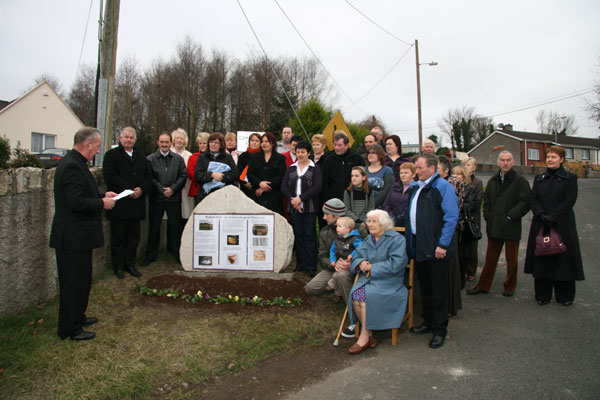8/4/10

Ballon Hill residents get their own marker stone.
And, also, some of the best views of the mountains.
4/1/09

The unveiling of the Heritage Plaque on Ballon Hill by Fr. Howard.
Looking West

Looking South
Ballon Hill has a uniform convex shape and is remarkably similar in silhouette from whichever direction it is viewed. Although only 450 feet above sea level it provides a marvelous view of the countryside boasting, it is said, sight of nine counties. Geologically the hill is of granite covered by limestone and then a bearing of yellow sand and earth. As most of the surrounding land is flat it must have been its shape and location that attracted early man to it. It has an intriguing history.
Historians believe that Ballon Hill was the burial
place of the King of Ireland, Cathair Mor, in 177AD. It is also believed
that the ancient games (see appendix for more information)
of mid Leinster were celebrated in the area. The discovery of burial urns
in the hill endorses the fact that it was used as a cemetery in ancient
times.
In the mid 1800's the peasants discovered large numbers of fictile vessels
over the surface of the hill. (A fictile vessel is one made of earth or
clay). They called them "pans and crocks". At that time trees
were being planted and a quarry was being opened so there was a great
disturbance of the area.
As a result of these finds Mr. John Lecky of Ballykealey House, the local
gentry, commenced a systematic exploration of the hill through his brother
in law Mr. Smyth. This covered a period 1852 to 1854.
Work started at the "Stone of the Dead" or Cloghan-na-Marbhan
as the locals always knew it. This is located on the hill side facing
Ballykealey House and stands eight feet above the ground and extending
three feet below. Local children today know it also as the slippery stone
as it used to make a great slide.

Mr. Smyth found it to be supported by granite blocks at each end and found three human skeletons there. Further excavation revealed more granite blocks and these covered a bed of charcoal and different broken urns. Further excavations on the hill, particularly around the rath, produced many more urns some of which were discovered in cists (Burial chambers). Some of the urns were beautifully decorated, some more crudely. The cists had the remains of charcoal and bones of animals and birds. It was concluded that the animal bones were associated with some form of pagan sacrifice.
Mr. Lecky had two of the cists re-erected near to his house and most of the urns where they were restored and housed in the library in the house. They remained there until 1928 when they were presented to the National Museum by Colonel Beauchamp Lecky.
They are still with the museum and date from about 500 BC to 1300 AD.
Question from John O'Neill in New Zealand: If St. Patrick who lived from about 388 to 463 AD was successful in converting Ireland to Christianity how come these vessels are still being made 837 years after his death??
For more information see the book Ballon and Rathoe by Peadar Mac Suibhne

These photos clearly show the fine details given in decorating the vessels. Clearly, the burial ceremony had a real significance to the Bronze Age people.
This vessel is a replica of the actual vessel but faithfully duplicates the original



